W
hen addressing the question “What will yarn preparation look like in the future?” there
are two different approaches. The first is the safer approach of looking at possible progressions
and developments in the existing technology, then predicting where this will lead in the future.
The second approach is not to be restricted by today’s technology. Starting only with the premise
of needing to translate bales of fiber into a strand, which is suitable to feed into a spinning
machine. In the present article, it is hoped to combine aspects of both of these approaches. Thus
not only will possible developments in processing stages be discussed, but also in some cases the
need (or techniques adopted) for the process may be questioned. An inherent assumption is also that
the properties of the fibers used will not radically change in the foreseeable future.
There is no doubt that the current trend for greater use of monitoring and control devices
will continue, as will the development in off-line testing equipment. This can be a double-edged
sword. While these systems provide data on the process and product that was not previously
available, they also provide the challenge of how to use the data. There are obvious benefits in
using data on fibers to optimize bale lay-down, or to determine drawframe performance by monitoring
sliver regularity. Unfortunately, there is presently a surfeit of results and the channelling of
data (preferably obtained from both on-line and off-line sources and collated into usable
information) to the appropriate individual, is a necessity, if these systems are to have any
long-term usefulness.
One of the major concerns expressed by spinners is that the current grading of cotton does
not reflect the ultimate quality of the yarn. Some spinners would prefer less effectively ginned
fiber, if this caused less fiber damage.
Opening
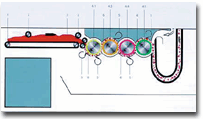 A
A
historical overview of the offerings by different machinery makers clearly shows that there has
been a rationalization in units used for opening and cleaning. Whereas, in the past there seemed to
be a multitude of apparently different concepts for opening and cleaning fibers. A cursory perusal
of the current offerings of machinery makers shows that there essentially seems to be a few core
components that can be modified to cater for different demands in terms of opening and/or cleaning.
An example of this is the Cleanomat/Tuftomat
(Figure 1) unit offered by Trützschler, where the basic design can be altered in terms of
number of rollers, roller covering and use of trash removal (mote knives) or “plain” under-screen.
By using the correct combination, it is claimed that optimum opening and cleaning can be achieved
with minimum fiber damage.
It is hard to foresee any major developments in bale opening systems, which are presently
available for either batch or continuous processing. Even in “batch” processing (normal bale
lay-down), it is currently possible to process almost 200 bales and up to three different bale
groups. Similarly the use of multimixers will be the integral component for efficient fiber
blending. With current production rates potentially well in excess of 1,000kg/hour, it is believed
that future developments may be aimed at improving quality rather than productivity.
Recent developments that will continue to grow in importance are:
• Fine Particle Cleaners (dedusting units): the successful use of high-speed spinning
machines (rotor, jet and vortex) requires that the feedstock is cleaner. For example, in rotor
spinning, fine dust particles in the feed lead to rotor deposits that not only reduce processing
efficiency, but can also result in moir — defects in the fabric. Similarly with jet/vortex
spinning, the presence of fine trash particles in units incorporating small holes to twist the
fibers could result in excessive wear and/or blocked channels that would in turn change product and
process quality.
• Foreign Parts Detection (metal, foreign fibers, etc.): as the feed to the opening process
becomes more automated, there is little opportunity for visual inspection and thus automatic
detection and elimination of unwanted material at an early stage is now a critical component of an
opening line. There are distinct benefits to early detection and removal of unwanted fibrous
material since later processing stages open up and spread out these “foreign fibers.” This can
result in the contamination of many yarn packages. Developments in automation coupled with advances
in image processing will further improve the efficiency of these units.
Carding
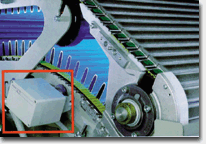 High-production
High-production
carding currently equates to throughputs of about 100kg/hour (maximum 120kg/hour) for a meter-wide
card. If developments in other carding technologies such as nonwovens are considered, there is no
doubt that further improvements in processing speed will be achieved in cotton cards. This may
however necessitate developments in the output from the card, such as dual doffers or some
alternative output format to the current sliver. This latter approach, which is used in woolen
processing, has been the subject of several research projects and includes the possibility of
spinning directly from the card.
While there has been continuous improvement in carding technology and in associated process
and product control, these seem to have come of age and rather than simply being “crowd-pullers” at
machinery shows, they now present an alternative approach to maintaining high quality in carding.
Multiple liquor-in rolls have been tried in the past, and this approach is being promoted by
Trützschler and is claimed to give better fiber opening. Other manufacturers have incorporated
modifications to the feed/liquor-in region aimed at better cleaning and minimum fiber damage.
Recent machinery exhibitions have unveiled several interesting developments from different
card manufacturers, each of which leads to a minor improvement. However, if these could be
integrated into one unit there is potentially a major change in the control of the carding process.
These developments include both new and established ideas:
• integrated flat grinding has been available for several years;
• automatic measurement of flat setting is now available;
• motorized flat setting
(Figure 2) is a possibility;
• an integrated cylinder grinding system
(Figure 3) was recently made available. This consists of a grind-stone mounted under the
cylinder which traverses the cylinder at intervals calculated by software (based on production and “
experience values”);
• autolevelling systems and the monitoring of sliver regularity is almost a standard
accessory; and
• automatic nep counting at the doffer is an established technology but this now forms the
basis of “intelligent grinding management.” Data from the automatic nep sensor can provide a useful
indication of appropriate times to grind the flats (i.e. when there is an unacceptable increase in
the level of neps).
It is thus evident that it is possible to measure sliver quality in terms of uniformity and
neps and, furthermore, the factors primarily responsible for sliver quality (i.e. the condition of
the card clothing and flat setting) can be adjusted. Thus, rather than grinding and adjusting card
settings on a fixed time interval, it is now potentially possible to make these adjustments when
the quality of the sliver approaches some predefined limit.
The possibility of incorporating a drafting head between the card and the coiler unit is not
new and has been the basis of earlier autolevelling systems and also an approach to eliminating
drawframe passages. A drawback of these systems was that they operated at very low drafts and this
could result in grouping of fibers, which became evident in subsequent drawing processes. The
recently introduced IDF (integrated drawframe) from Trützschler is claimed to overcome the earlier
limitations by operating at significantly higher drafts between two and three. Indeed it is claimed
that significant improvements in fiber straightening (resulting in greater fiber length and yarn
strength)
(Figure 4) can be achieved at drafts greater than two.
There are differences of opinion over the use of an integrated drafting system as an
alternative to a drawframe passage (since this reduces the doubling and hence blending potential of
the processing line). However, this approach may become a standard feature of “cards of the future”
should double doffers become a necessary requisite for higher productivity.
The other technology, that may re-emerge, is the use of a direct link between card and
drawframe. While this has been proposed several times previously, any future balance in production
levels of cards and drawframes may re-establish interest in this approach.
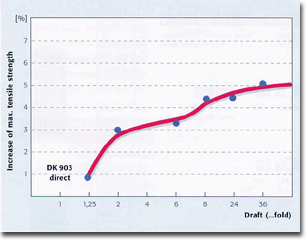
Combing
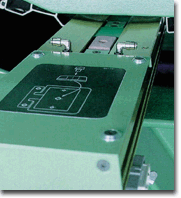 Combing
Combing
preparation is potentially totally automated, including the transfer of laps to the comb, and it is
unlikely that any major developments will be seen in this area. Unless there is a radical departure
from the current design of combing machines, it is unlikely that they will make any significant
increases in speeds beyond 400 nips/minute. An area where improvements may be seen is the automatic
setting of the comb to achieve some preset quality standards.
The use of imaging systems on the combed web can be used to assess not only the nep and trash
particle content, but potentially could also determine fiber length and fineness. The data from
these sensors could be part of a system that self-adjusts the comb settings and thus yields
consistent quality.
Drawing
Drawframe speeds have peeked at about 1,000m/min. Autolevelling systems are available from all
drawframe manufacturers, as is the possibility of automatic can change and the potential of a
material handling (can transport) system. It is likely that there may be greater use of rectangular
cans (originally promoted by Rieter with their CUBI can system), since these not only provide
better use of the available space under modern spinning frames, but also offer easier handling in
an automated transport system. The relative advantages and disadvantages of reducing drawframe
passages are still the subjects of debate, but it is likely that there will be a move to the use of
integrated drawing systems where two drawframes are essentially combined into one unit.
Systems of this type were proposed almost 50 years ago by Toyobo
(Figure 5) for cotton spinning and more recently by Sant’Andrea Novara and OKK for worsted
processing and it seems logical that such a set-up should figure in a drawing line of the future.
As mentioned earlier, the old idea of linking several cards to a drawframe may also reappear if
production levels can be matched. The drawframe of the future may also be “smarter” than today,
where it responds to data input from previous machines and/or integrated sensing systems.
Potentially the machine may optimize draft, ratch, and production speed based on values of fiber
properties (obtained from high-volume tests) and regularity of the final sliver.
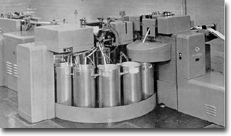
Roving Frame
There has been a question mark over the future of the roving frame for the last 40 years, but it
still forms the feedstock for ring spinning. There is, however, current renewed interest in the use
of higher drafts on the ring frame and this leads to the possibility of using heavier feedstock.
Thus, it is possible to eliminate the roving frame and use a lightweight sliver to feed the ring
frame. A further route to improving the total efficiency of the ring spinning process is to utilize
heavyweight rovings in terms of both roving count and package size and weight (up to 5 kg). The use
of heavy rovings offers several advantages:
• the production of the roving frame is greatly increased;
• automatic doffing of the roving frame is a well-developed technology;
• automatic transport of rovings and creeling of ring frame is easier to perform than the
transport of sliver cans; and
• space requirement at the ring frame is significantly less than with sliver feeds.
As indicated above there is unlikely to be any major increases in productivity of the
machines utilized in spinning preparation and likely benefits will probably be achieved by
increases in the throughput weights rather than speed. The possibility of shortened processing
routes should not be discounted for certain types of yarn, but while direct spinning from the card
may be an interesting research topic, it is extremely unlikely to be of any commercial
significance. The greater availability of cheaper and more powerful microprocessors; cheaper and
more sophisticated imaging systems; cheaper variable speed motors and drivers; and access to more
data on fiber and sliver quality will inevitably result in smart, more integrated machines, which
automatically respond to compensate for changes in quality.
Editor’s Note: William Oxenham is professor, associate department head and graduate
administrator in the Department of Textile and Apparel Technology and Management in the College of
Textiles at North Carolina State University. Oxenham earned his bachelor’s degree and doctorate at
the University of Leeds, England.
April 2000




